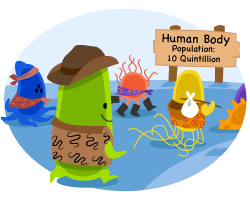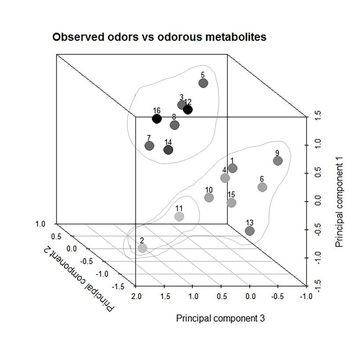
Science explains why some people smell worse than others despite keeping themselves squeaky clean.
The body is crawling with microbes that have evolved with the person, depending on the innate metabolism, history of infections, microbiome swaps, diet and lifestyle. The body's ecosystem of microorganisms can increase the risk for dangerous diseases for which we have unreserved levels of sympathy. It can also lead to unlikable conditions such as unpredictable and embarrassing outbursts of odor emitting through the pores - odor so bad it ruins social lives and careers. 
There is no cure for conditions responsible for odorous microbiomes. A rare disease TMAU (Trimethylaminuria) - an inborn error of choline metabolism that leads to the excessive excretion of foul-smelling trimethylamine (TMA) in the sweat and breath - can sometimes be managed by unhealthy diet very low in choline. A purely-microbiome-caused case of armpit odor may be fixed by microbial transplantation. But research is still in its early stages and is mostly unfunded.
Our community-led clinical trial was the first study attempting to find what is in common among individuals suffering from odor unexplained by known medical conditions such as TMAU. We have demonstrated that symptoms described by participants are real - as they correlate with a number of laboratory tests. We have also proposed that there are at least two groups of participants with different genetics/medical histories (hence different microbiomes) that may require different types of treatments. Unfortunately publishing these results is very difficult - with no funding to cover publication fees and no "sex appeal" to get support from peers. (The article was submitted to the Journal of Participatory Medicine in February, but peer-reviewers still have not returned their reviews) The preprint is now available at bioRxiv and raw results at Mendeley. Study results will be also available on the clinical trials site. We hope that the scientific community will look into our findings and support the underserved by their attention. Any comments or suggestions would be of great help!
REFERENCE
Irene S. Gabashvili (2017). Community-led research discovers links between elusive symptoms and clinical tests BiorXiv DOI: 10.1101/139014
 Human skin emits light (albeit the glow is extremely weak) and a wide variety of small molecules that may be sometimes "sniffed" by dogs or even other humans. These chemicals tell a story about our health and wellness, things we eat and drink, touch and breathe. Mosquitoes use such emissions to assess our "attractiveness" from indicators such as Indoles (unpleasantly smelling but healthy "inner soil" biomarker) or carbon dioxide (amount of which correlates with the size of the person producing it) in the air.  Sampling air for health indicators is much less invasive than drawing blood and could be an invaluable diagnostic tool. Many applications of gas sensors have been proposed over decades ranging from sweat patches to sensorized garments. Where are we now? What is the 2016 state of the art?  Can we recognize if people around us are stressed, anxious or fearful without observing their facial expressions, body language and actions or hearing their voice and messages? What about our own stress - assuming we don't rely on heart rate, blood pressure, dry throat, sweating, drops or surges in energy? Yes, we can - by using our nose - as humans, too, recognize and transmit their emotions through chemical senses ...  The $10 million Qualcomm Tricorder X Prize and $2.25 million Nokia Sensing Challenges are trying to identify the best portable technologies for diagnosing disease - as easily as Dr. McCoy's tricorder of the 23rd Century could. What scientific knowledge could help us to develop it in this age? Detecting metabolites, sensing DNA, imaging the nanoworld of the human body or interaction between matter and energy?... |
Categories
All
Environment
|
 RSS Feed
RSS Feed
